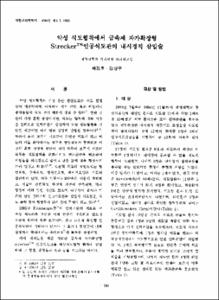KUMEL Repository
1. Journal Papers (연구논문)
1. School of Medicine (의과대학)
Dept. of Internal Medicine (내과학)
악성 식도협착에서 금속제 자가확장형 StreckerTM™ 인공식도관의 내시경 삽입술
- Keimyung Author(s)
- Kang, Young Woo
- Department
- Dept. of Internal Medicine (내과학)
- Journal Title
- 대한내과학회지
- Issued Date
- 1995
- Volume
- 49
- Issue
- 6
- Abstract
- Objectives: Endoscopic intubation is well established as a cheap, durable, and prompt effective procedure for palliation of malignant dysphagia, and also have an advantage in short stay in hospital. However, with conventional plastic tube protheses, esophageal intubation continues to be plagued by high morbidity and mortality as well as limited effectiveness in the relief of dysphagia. We discribed an experience with metallic self-expanding Strecker™ esophageal stent placement in patients with malignant esophageal obstruction.
Methods: From July 1993 to November 1994, twelve consecutive patients with severe dysphagia due to malignant esophageal obstruction were treated with metallic self-expanding Strecker™ esophageal stent(Boston Scientific®). Thirteen stents were placed in twelve patients.
Results:
1) Marked reduction of dysphagia was noted in all patients the day after stent insertion, and most of the patients received a normal diet thereafter. Macroscopically obvious ingrowth of tumor through the stent mesh was seen at endoscopy in four patients at 1 to 5 months after insertion of the stent. But, These stents were successfully recanalized with endoscopic balloon dilatation and second stent insertion. And then improvement has been sustained for the mean follow up duration, 28.5±17.7 weeks.
2) These were several complications such as, chest pain(3 patients) and bleeding(2 patients) during stent placement, and tumor ingrowth(4 patients)and perforationd patients) after stent placement. But all these complication were successfully treated with several managements such as esophageal ballon dilatation, second stent placement, and supportive care, except perforation. A case complicated by perforation was died of mediastinitis and sepsis four weeks after implantation, but caused by preim-plantation esophageal balloon dilatation.
3) The mean survival duration( ±SD) was 20.2 ± 10.2 weeks and 37.4±18.6 weeks in six died and five survived patients, respectively. Conclusion: Endoscopic insertion of metallic self-expanding Strecker™ stent was a safe and effective procedure for palliative treatment of malignant esophageal strictures. However, newly designed stent should be developed to overcome tumor ingrowth.
목적: 악성식도협착의 보존적 치료중 인공식도삽관술은 비용이 저렴하고, 시술이 간편하고, 중상의 개 선이 신속하며, 다른 방법에 비해 입원기간도 짧으며, 내구성이 좋으나 기존의 경성 플라스틱 인공식도관은 삽입시 식도천공, 식도출혈 등의 합병증이 많은 것이 문제시 되고 있다. 이에 저자들은 최근 개발된 금속제 자가확장형 Strecker™인공식도관올 악성 식도협착 환자에 삽입하여 그 효과, 부작용과 장점을 보고하는 바이다.
방법:1993년 7월부터 1994년 11월까지 계명대 학교 동산의료원에 내원한 식도암 11예, 위암 1예로 총 12명의 환자를 대상으로 했다. 1명은 2회의 인공 식도삽관술을 시행하여 모두 13회의 시술올 했다. 사 용한 튜브는 미국 Boston Scientiffic사의 Strecker™인공식도관올 사용했다.
결 과:
1) 전체 12명 환자 모두에서 연하곤란은 현저히 개 선되었고, 4명에서 1개월에서 5개월사이에 식도협착이 재발되었으나 식도풍선확장술과 두 번째 인공식도관의 삽입으로 중상의 호전을 보였고 나머지 환자들의 중상 의 재발은 추적기간 동안은 나타나지 않았다.
2) 인공식도관 삽입하는 동안에는 흉통(3예)과 출 혈(2예), 삽관후에는 식도천공(1예)과 종양의 인공식 도관내 성장으로 인한 식도재협착(4예)등의 부작용이 관찰되었으나 식도천공이 있었던 1예를 제외하고는 모두 보존적 요법으로 치료되었으며 식도천공이 있었 던 1예는 인공식도관 삽입술전 식도풍선확장술로 인 한 것으로 생각된다.
3)인공식도관 삽입시로부터 1994년 11월(흑은 사망) 까지를 생존기간으로 볼때,사망한 환자 6명에서 평균생 존기간은 20.2±10.2주여주-32주)이고, 생존해 있는 환자 5명에서 평균생존기간은 37.4:±18.6주(12주-58주)이었다.
결론:금속제 자가확장형 Strecker™인공식도관 삽입술은 술기가 간편하고, 충분한 길이를 가지며, 연 하곤란의 중상완화에 효과적이며, 삽입시 발생하는 부 작용도 다른 치료방법에 비해 적은 것으로 나타났다. 앞으로 이 인공식도관의 보완점올 개선한 새로운 재질 의 인공식도관의 개발이 필요하다고 생각한다.
- Alternative Title
- Endoscopic Insertion of Self-expanding Strecker™ Stent for Malignant Esophageal Strictures
- Keimyung Author(s)(Kor)
- 강영우
- Publisher
- School of Medicine
- Citation
- 배장호 and 강영우. (1995). 악성 식도협착에서 금속제 자가확장형 StreckerTM™ 인공식도관의 내시경 삽입술. 대한내과학회지, 49(6), 760–768.
- Type
- Article
- ISSN
- 1226-329x
- Appears in Collections:
- 1. School of Medicine (의과대학) > Dept. of Internal Medicine (내과학)
- 파일 목록
-
-
Download
 oak-bbb-00736.pdf
기타 데이터 / 743.29 kB / Adobe PDF
oak-bbb-00736.pdf
기타 데이터 / 743.29 kB / Adobe PDF
-
Items in Repository are protected by copyright, with all rights reserved, unless otherwise indicated.